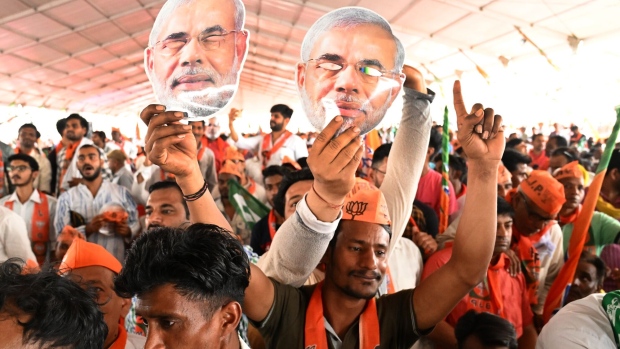Apr 22, 2024
Modi’s Path to a 400-Seat Goal Runs Through India’s South, East
, Bloomberg News

(Bloomberg) -- With the India elections underway, follow Bloomberg India's channel on WhatsApp for how money and business intersect with politics and power. Sign up here.
India’s Prime Minister Narendra Modi has been predicting his Bharatiya Janata Party-led coalition can sweep three out of every four parliament seats as he criss-crosses the country to charm voters. Analysts and election strategists from his party say the task isn’t entirely impossible, but will likely be difficult.
Modi has set sights on the ruling coalition, the National Democratic Alliance, or NDA, exceeding 400 out of 543 seats in the lower house of parliament after votes are counted on June 4.
To do that he’ll have to replicate the NDA’s exceptional showing in northern India in the 2019 election, win more seats in the south — which has so far proved immune to his charm — and wrest power in the west and restive eastern parts of the country.
“The NDA won 352 seats last time and to cross 400 they need 48 seats more,” Pradeep Gupta, chairman of polling company Axis My India, said in an interview before the country began voting on April 19. “Much depends how BJP and NDA performs in states like Tamil Nadu, Kerala, Andhra Pradesh in southern India.”
The last time anyone achieved such a crushing win was in 1984, when the Indian National Congress won 404 seats after a sympathy wave swept the country in the aftermath of then-prime minister Indira Gandhi’s assassination.
Winning that many seats will give Modi’s alliance more than a two-thirds majority in the lower house of Parliament. The ruling coalition would need two-thirds backing in both the upper and lower houses of Parliament in order to change the Constitution.
India’s Six-Week Election Is a Test of Modi’s Power: QuickTake
Modi is being buoyed by several factors that may help him meet his seat target. India is one of the fastest-growing major economies, a temple where a centuries-old mosque once stood is now open — boosting the BJP’s Hindu nationalist push — and the opposition has been hit by defections and arrests of some of its leaders.
That doesn’t mean its a done deal though. Indian voters are fickle and anti-incumbency sentiment runs strong. Several parties remain dominant in their regional strongholds too.
Here are the opportunities and challenges Modi faces in his quest to meet his lofty goals:
Southern Foray
The BJP and its allies can reach Modi’s target if they can substantially increase their tally in the 130 seats from the southern states, according to polling company Axis My India. The NDA currently holds 31 seats in those regions.
“The BJP will have to break ground in southern India,” said Neelanjan Sircar, a senior fellow at the Delhi-based Centre for Policy Research. Modi will have to do well in Tamil Nadu, Andhra Pradesh and Telangana in order to achieve 370-400 seats overall, he added.
That’s easier said than done. The BJP has traditionally had less sway in the south where voters prefer regional parties that promote local languages over Hindi, and where the ruling party’s Hindu nationalism message doesn’t resonate much. Political leaders there also say they’re not getting their fair share of tax revenue from federal coffers.
Modi, who is the face of the BJP campaign and even the star of the party’s manifesto, is making a strong pitch to skeptical voters. He has visited the southern states almost a dozen times in the past six months and even dredged up a decades-old diplomatic issue, blaming the opposition for ceding an island to neighboring Sri Lanka.
Maharashtra Battle
The BJP’s alliance with a party in India’s wealthiest state in the west, Maharashtra, delivered 41 of the 48 federal lawmakers to Modi in 2019. It also won a majority in the state assembly. But the pact broke down over differences in forming the state government and in the end the Shiv Sena cobbled together a coalition with the opposition and other smaller groups.
But things have since been looking up for the BJP. In 2022, the Shiv Sena split into two with one faction siding with the BJP, which led to the chief minister’s resignation and a new coalition dominated by the BJP taking over the state government.
An internal BJP survey showed it will gain the parliamentary seats currently held by the opposition-backed rival Shiv Sena faction, according to senior members of the party who asked not to be named as they are not authorized to speak about electoral strategy. The BJP will make headway as it has a strong campaign network on the ground, they added.
The BJP didn’t respond to requests for comments.
Eastern Advance
The party sees its parliament seat tally significantly rising in the east, particularly in the states of West Bengal and Odisha. Internal assessments show the BJP could bag half of the 42 parliament seats in West Bengal due to negative media coverage about law and order in the state, the people said. In 2019, the BJP won 18 seats.
West Bengal Chief Minister Mamata Banarjee, however, remains a strong force on the ground. Her party, the All India Trinamool Congress, has been in power in the state since 2011. Despite a strong push by the BJP, she won more seats in the 2021 state elections than the previous one in 2016.
In another eastern state, Odisha, the BJP expects to win nearly two thirds of the 21 seats compared to a third in 2019, the BJP officials said, as voters may look for a change from regional party Biju Janata Dal, in power for over two decades.
The main opposition party, the Indian National Congress said they are “confident and upbeat about about our prospects,” especially after the first phase of India’s six-week long elections that began on April 19. “The BJP will not be anywhere near its target,” said Pawan Khera, a spokesperson for the party, in a phone conversation. He added that economic inequality, unemployment and farmer distress — issues the Congress has been campaigning on — were resonating with voters.
Hindi Heartland
Modi’s coalition will need to maintain its 2019 win rate of 92% of the 257 seats from the Hindi-speaking heartland comprising most of central and northern India. His party expects to do better in Uttar Pradesh, which sends 80 lawmakers to parliament — the most in the country, the people said. It won 64 seats in the last election.
The BJP’s support in state assembly elections has been strong, although that doesn’t mean voters will go the same way in the national polls. The party extended its grip on Uttar Pradesh for a second term in 2022 — the first time any party has done this in four decades. It went on to retain power in Madhya Pradesh and wrested control of Rajasthan and Chhattisgarh assemblies in December on the back of Modi’s star power, government handouts and economic growth.
Even so, retaining every seat in the national elections might be difficult.
“Losing some seats cannot be ruled out,” said Axis My India’s Gupta. “A decade in power leads to fatigue and anti-incumbency.”
(Adds clarification in fourth paragraph.)
©2024 Bloomberg L.P.








